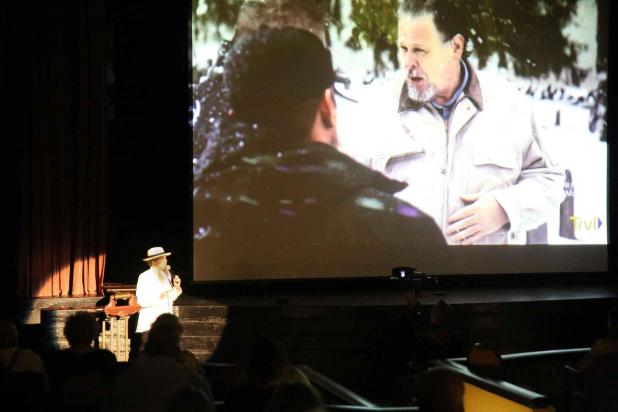
The Daily Review/Bill Decker
Diane Wiltz introduces "Ghosts of Morgan City" at Friday's watch party at Franklin's Teche Theatre.
From the Editor: Nobody wants to live in a ghost town
To judge by Facebook, St. Mary people were excited to see “Ghosts of Morgan City” Friday on the Travel Channel. Many of them even gathered at Franklin’s Teche Theatre for the Performing Arts to watch the premiere on a big screen.
The show touched on the Ada LeBoeuf murder case that resulted in her execution by hanging in 1929.
It was the second scariest thing I heard last week.
The first came on Thursday, in a casual conversation with someone who has an important job and is active in civic affairs. The talk turned to the local economy, and this person stated flat out what many of us worry about: “St. Mary is dying.”
I won’t rat the person out. The conversation wasn’t intended to be on the record, or I wouldn’t have been showing pictures of my new grandbaby (Paisley Mae, 12:07 a.m. June 16, 6 pounds, 14 ounces). But this person has the sort of job from which you expect to hear more boosterism than pessimism.
That’s scary.
Oddly enough, the ghosts and the worries aren’t completely unrelated.
“Ghosts of Morgan City,” which will continue for seven more episodes featuring towns across the parish, is a follow-up to the Travel Channel’s “Ghosts of Shepherdstown” about paranormal happenings in a small West Virginia town.
Diane Wiltz, who worked with the producers on the Morgan City series, was at Friday’s watch party. Wiltz said she’s heard Shepherdstown saw a significant boost in tourism after the first series appeared.
Maybe any national attention is good attention. But do we really want to be known for something creepy, the way Salem is known for burning witches and Roswell is known for dead aliens?
Wiltz noted that St. Mary is trying to bring in more tourism dollars.
“If the TV program can help us do what we’re trying to do on our own, sign me up,” she said.
It’s a good point.
West Virginia, like Louisiana, is suffering from its long history of economic over-dependence on a fossil fuel. The national attention they get, like the publicity we get, tends to be about the quaint goings-on of the local people: mountain folk in West Virginia, Cajuns in Louisiana.
As long as the rest of the country is getting the bubble-gum comic version anyway, why not bring in a few bucks to keep the schools open and pave the highways?
Maybe we shouldn’t be looking for economic lightning to strike again, the way it did after Morgan City became a base of operations for the first out-of-sight offshore oil production in the 1950s. It’s not like Jeff Bezos is thinking, “Amazon 2 probably won’t work in New York. Let’s try Verdunville.”
If the St. Mary economy is to be transformed, we might have to do it one little piece at a time.
We’ve written about the Urban Land Institute study commissioned by the St. Mary Excel group earlier this year. The resulting report lays out a lot of ways to improve our economy, but there are no silver bullets in there. A lot of it is making better use of features we have already, like our shipbuilding and repair infrastructure and our waterfronts.
Parish President David Hanagriff and Economic Development Director Frank Fink made the rounds at city council meetings, looking for the authority to approve property tax exemptions for new and expanding industry. It seems like a little thing, but those potential employers won’t have to trudge from meeting to meeting to seek a little help with creating new jobs.
Maybe the key to our future is all those little things. It’ll take a lot of work.
But working is something St. Mary people know how to do.
Bill Decker is the managing editor of The Daily Review.
